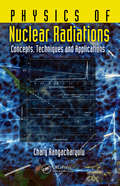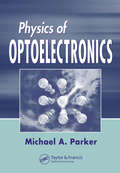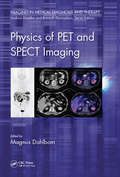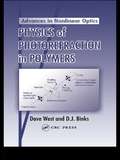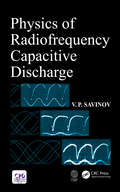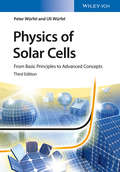- Table View
- List View
Physics of Nuclear Radiations: Concepts, Techniques and Applications
by Chary RangacharyuluThis text makes the physics of nuclear radiations accessible to students with a basic background in physics and mathematics. Rather than convince students one way or the other about the hazards of nuclear radiations, the text empowers them with tools to calculate and assess nuclear radiations and their impact. It discusses the meaning behind mathematical formulae as well as the areas in which the equations can be applied. Coverage includes archeology, health, and medical physics applications.
Physics of Optoelectronics (Optical Science and Engineering)
by Michael A. ParkerPhysics of Optoelectronics focuses on the properties of optical fields and their interaction with matter. Understanding that lasers, LEDs, and photodetectors clearly exemplify this interaction, the author begins with an introduction to lasers, LEDs, and the rate equations, then describes the emission and detection processes.The book summarizes and reviews the mathematical background of the quantum theory embodied in the Hilbert space. These concepts highlight the abstract form of the linear algebra for vectors and operators, supplying the "pictures" that make the subject more intuitive. A chapter on dynamics includes a brief review of the formalism for discrete sets of particles and continuous media. It also covers the quantum theory necessary for the study of optical fields, transitions, and semiconductor gain. This volume supplements the description of lasers and LEDs by examining the fundamental nature of the light that these devices produce. It includes an analysis of quantized electromagnetic fields and illustrates inherent quantum noise in terms of Poisson and sub-Poisson statistics. It explains matter-light interaction in terms of time-dependent perturbation theory and Fermi's golden rule, and concludes with a detailed discussion of semiconductor emitters and detectors.
Physics of Oscillations and Waves: With Use Of Matlab And Python (Undergraduate Texts In Physics Ser.)
by Arnt Inge VistnesIn this textbook a combination of standard mathematics and modern numerical methods is used to describe a wide range of natural wave phenomena, such as sound, light and water waves, particularly in specific popular contexts, e.g. colors or the acoustics of musical instruments. It introduces the reader to the basic physical principles that allow the description of the oscillatory motion of matter and classical fields, as well as resulting concepts including interference, diffraction, and coherence. Numerical methods offer new scientific insights and make it possible to handle interesting cases that can’t readily be addressed using analytical mathematics; this holds true not only for problem solving but also for the description of phenomena. Essential physical parameters are brought more into focus, rather than concentrating on the details of which mathematical trick should be used to obtain a certain solution. Readers will learn how time-resolved frequency analysis offers a deeper understanding of the interplay between frequency and time, which is relevant to many phenomena involving oscillations and waves. Attention is also drawn to common misconceptions resulting from uncritical use of the Fourier transform. The book offers an ideal guide for upper-level undergraduate physics students and will also benefit physics instructors. Program codes in Matlab and Python, together with interesting files for use in the problems, are provided as free supplementary material.
Physics of PET and SPECT Imaging (Imaging in Medical Diagnosis and Therapy)
by Magnus DahlbomPET and SPECT imaging has improved to such a level that they are opening up exciting new horizons in medical diagnosis and treatment. This book provides a complete introduction to fundamentals and the latest progress in the field, including an overview of new scintillator materials and innovations in photodetector development, as well as the latest system designs and image reconstruction algorithms. It begins with basics of PET and SPECT physics, followed by technology advances and computing methods, quantitative techniques, multimodality imaging, instrumentation, pre-clinical and clinical imaging applications.
Physics of Petroleum Reservoirs (Springer Mineralogy)
by Xuetao Hu, Shuyong Hu, Fayang Jin and Su HuangThis book introduces in detail the physical and chemical phenomena and processes during petroleum production. It covers the properties of reservoir rocks and fluids, the related methods of determining these properties, the phase behavior of hydrocarbon mixtures, the microscopic mechanism of fluids flowing through reservoir rocks, and the primary theories and methods of enhancing oil recovery. It also involves the up-to-date progress in these areas. It can be used as a reference by researchers and engineers in petroleum engineering and a textbook for students majoring in the area related with petroleum exploitation.
Physics of Photorefraction in Polymers (Advances in Nonlinear Optics)
by Dave West D.J. BinksPhotorefractive polymer composites are an unusually sensitive class of photopolymers. Physics of Photorefraction in Polymers describes our current understanding of the physical processes that produce a photorefractive effect in key composite materials. Topics as diverse as charge generation, dispersive charge transport, charge compensation and trapping, molecular diffusion, organic composite structure, and nonlinear optical wave coupling are all developed from a physical perspective. Emphasis is placed on explaining how these physical processes lead to observable properties of the polymers, and the authors discuss various applications, including holographic archiving.
Physics of Quantum Fluids: New Trends and Hot Topics in Atomic and Polariton Condensates
by Alberto Bramati Michele ModugnoThe study of quantum fluids, stimulated by the discovery of superfluidity in liquid helium, has experienced renewed interest after the observation of Bose-Einstein condensation (BEC) in ultra-cold atomic gases and the observation a new type of quantum fluid with specific characteristics derived from its intrinsic out-of-equilibrium nature. The main objective of this book is to take a snapshot of the state-of-the-art of this fast moving field with a special emphasis on the hot topics and new trends. Bringing together the most active specialists of the two areas (atomic and polaritonic quantum fluids), we expect that this book will facilitate the exchange and the collaboration between these two communities working on subjects with very strong analogies.
Physics of Quantum Rings
by Vladimir FominThis book deals with a new class of materials, quantum rings. Innovative recent advances in experimental and theoretical physics of quantum rings are based on the most advanced state-of-the-art fabrication and characterization techniques as well as theoretical methods. The experimental efforts allow to obtain a new class of semiconductor quantum rings formed by capping self-organized quantum dots grown by molecular beam epitaxy. Novel optical and magnetic properties of quantum rings are associated with non-trivial topologies at the nanoscale. An adequate characterization of quantum rings is possible on the basis of modern characterization methods of nanostructures, such as Scanning Tunneling Microscopy. A high level of complexity is demonstrated to be needed for a dedicated theoretical model to adequately represent the specific features of quantum rings. The findings presented in this book contribute to develop low-cost high-performance electronic, spintronic, optoelectronic and information processing devices based on quantum rings.
Physics of Quantum Rings (NanoScience and Technology)
by Vladimir M. FominThis book, now in its second edition, introduces readers to quantum rings as a special class of modern high-tech material structures at the nanoscale. It deals, in particular, with their formation by means of molecular beam epitaxy and droplet epitaxy of semiconductors, and their topology-driven electronic, optical and magnetic properties. A highly complex theoretical model is developed to adequately represent the specific features of quantum rings. The results presented here are intended to facilitate the development of low-cost high-performance electronic, spintronic, optoelectronic and information processing devices based on quantum rings. This second edition includes both new and significantly revised chapters. It provides extensive information on recent advances in the physics of quantum rings related to the spin-orbit interaction and spin dynamics (spin interference in Rashba rings, tunable exciton topology on type II InAs/GaAsSb quantum nanostructures), the electron-phonon interaction in ring-like structures, quantum interference manifestations in novel materials (graphene nanoribbons, MoS2), and the effects of electrical field and THz radiation on the optical properties of quantum rings. The new edition also shares insights into the properties of various novel architectures, including coupled quantum ring-quantum dot chains and concentric quantum rings, topologic states of light in self-assembled ring-like cavities, and optical and plasmon m.odes in Möbius-shaped resonators.
Physics of Quantum Rings (NanoScience and Technology)
by Vladimir M. FominThe book represents quantum rings as special class of modern high-tech materials structures at the nanoscale. It deals, in particular, with their formation by molecular beam epitaxy and droplet epitaxy of semiconductors, their topology-driven electronic, optical and magnetic properties. Highly complex theoretical models are developed to adequately explain the specific features of quantum rings. The results presented in the book serve to develop low-cost high-performance electronic, spintronic, magnetic, optoelectronic and information processing devices based on various doubly-connected structures. The third edition contains new chapters and significantly updated and extended chapters from the second edition. It provides an ample presentation of the recent advancements in the physics of quantum rings related to spin dynamics and the spin-orbit interaction (spin interference in Rashba rings, tunable exciton topology on type II InAs/GaAsSb quantum nanostructures), the electron-phonon interaction in ring-like structures, quantum-interference manifestations in novel materials (e.g., graphene cylinders, cyclocarbons, MoS2), effects of electric field and THz radiation on optical properties of quantum rings and quantum-ring molecules. Special emphasis is made on fascinating novel effects emerging due to double-connectedness in various physical systems, ranging from the occurrence of the continuous geometric phase provoking formation of non-integer mode numbers in Möbius microring light cavities—through the inverse Faraday effect on the generation of current states in an array of superconductor nanorings—to the emergence of lightning-like magnetic flux bursts into a macroscopic superconductor ring. The new edition gives insight into the properties of various novel architectures, including coupled semiconductor quantum ring-quantum dot chains and concentric quantum rings, In(AsSbP) graded-composition quantum rings, topologic states of light in self-assembled and direct-printed ring-like cavities, optical and plasmon modes in Möbius-band-shaped resonators, the ferromagnetic resonance in various magnetic elements ranging from arrays of magnetic nanorings to individual 3D nanovolcanoes. It includes novel theoretical solutions to long-standing problems in the physics of quantum rings: interpretation of the observed magnetoresistance oscillations by a transmission model for superconductor quantum rings and adaptation of the Bardeen-Cooper-Schrieffer theory of superconductivity for metallic quantum rings with due account for the effects of double-connectedness on the electron properties.
Physics of Radiation and Climate
by Michael A. Box Gail P. BoxOur current climate is strongly influenced by atmospheric composition, and changes in this composition are leading to climate change. Physics of Radiation and Climate takes a look at how the outward flow of longwave or terrestrial radiation is affected by the complexities of the atmosphere's molecular spectroscopy. This book examines the planet in
Physics of Radio-Frequency Plasmas
by Pascal Chabert Nicholas BraithwaiteLow-temperature radio frequency plasmas are essential in various sectors of advanced technology, from micro-engineering to spacecraft propulsion systems and efficient sources of light. The subject lies at the complex interfaces between physics, chemistry and engineering. Focusing mostly on physics, this book will interest graduate students and researchers in applied physics and electrical engineering. The book incorporates a cutting-edge perspective on RF plasmas. It also covers basic plasma physics including transport in bounded plasmas and electrical diagnostics. Its pedagogic style engages readers, helping them to develop physical arguments and mathematical analyses. Worked examples apply the theories covered to realistic scenarios, and over 100 in-text questions let readers put their newly acquired knowledge to use and gain confidence in applying physics to real laboratory situations.
Physics of Radiofrequency Capacitive Discharge
by V. P. SavinovThis book describes the physical mechanism of high-frequency (radio-frequency) capacitive discharge (RFCD) of low and medium pressure and the properties of discharge plasma in detail. The main properties and characteristics of RFCD, the features of electric breakdown in a high-frequency field are also investigated. The properties of near-electrode layers of a spatial discharge, the nature of the electric field in them, and the processes of charge transport to electrodes are explored. The work is intended for scientists engaged in gas discharge physics and low-temperature plasmas, graduate students and students of physics, physical chemistry, and relevant specialties.
Physics of Sailing
by John KimballBreaking down the complicated concepts of speed, acceleration, torque, fluid mechanics, and surface physics, Physics of Sailing provides a lively, easily accessible introduction to the basic science underlying the sport of sailing. It illustrates the many ways physics can be used to understand the principles of sailboat propulsion and how a scienti
Physics of Satellite Surface Charging: Causes, Effects, and Applications
by Shu T. Lai Rezy PradiptaThis book will explore the fundamentals of spacecraft charging: why it occurs, when it occurs, where it occurs, how to measure it, and its side effects. It will discuss state-of-the-art spacecraft charging technologies, which will be explained in detail and with pedagogical emphasis. Exercises for further learning will be included to facilitate a deeper understanding of the material. It will be of interest to advanced undergraduate and graduate students, in addition to researchers working in physics and engineering keen to understand more about spacecraft interactions with space plasmas. Key Features: Translates complex terminology into accessible language Authored by experts in the field Provides worked examples and exercises for further learning
Physics of Semiconductors 2002: Proceedings of the 26th International Conference, Edinburgh, 29 July to 2 August 2002 (Institute of Physics Conference Series)
by A R Long J H DaviesThe 26th International Conference on the Physics of Semiconductors was held from 29 July to 2 August 2002 at the Edinburgh International Conference Centre. It is the premier meeting in the field of semiconductor physics and attracted over 1000 participants from leading academic, governmental and industrial institutions in some 50 countries around the world. Plenary and invited papers (34) have been printed in the paper volume, and all submitted papers (742) are included on the downloadable resources.These proceedings provide an international perspective on the latest research and a review of recent developments in semiconductor physics. Topics range from growth and properties of bulk semiconductors to the optical and transport properties of semiconductor nanostructures. There are 742 papers, mostly arranged in chapters on Bulk, dynamics, defects and impurities, growth (147); Heterostructures, quantum wells, superlattices - optical (138); Heterostructures, quantum wells, superlattices - transport (97); Quantum nanostructures - optical (120); Quantum nanostructures - transport (85); New materials and concepts (52); Novel devices (43); and Spin and magnetic effects (48). A number of trends were identified in setting up the overall programme of the conference. There were significant contributions from new directions of research such as nanostructures and one-dimensional physics; spin effects and ferromagnetism; and terahertz and subband physics. These complemented areas in which the conference has traditional strengths, such as defects and bulk materials; crystal growth; quantum transport; and optical properties.As a record of a conference that covers the whole range of semiconductor physics, this book is an essential reference for researchers working on semiconductor physics, device physics, materials science, chemistry, and electronic and electrical engineering.
Physics of Semiconductors and Nanostructures
by Jyoti Prasad Banerjee Suranjana BanerjeeThis book is a comprehensive text on the physics of semiconductors and nanostructures for a large spectrum of students at the final undergraduate level studying physics, material science and electronics engineering. It offers introductory and advanced courses on solid state and semiconductor physics on one hand and the physics of low dimensional semiconductor structures on the other in a single text book. Key Features Presents basic concepts of quantum theory, solid state physics, semiconductors, and quantum nanostructures such as quantum well, quantum wire, quantum dot and superlattice In depth description of semiconductor heterojunctions, lattice strain and modulation doping technique Covers transport in nanostructures under an electric and magnetic field with the topics: quantized conductance, Coulomb blockade, and integer and fractional quantum Hall effect Presents the optical processes in nanostructures under a magnetic field Includes illustrative problems with hints for solutions in each chapter Physics of Semiconductors and Nanostructures will be helpful to students initiating PhD work in the field of semiconductor nanostructures and devices. It follows a unique tutorial approach meeting the requirements of students who find learning the concepts difficult and want to study from a physical perspective.
Physics of Shock Waves and High-Temperature Hydrodynamic Phenomena
by Ya. B. Zel’dovich Yu. P. RaizerHigh temperatures elicit a variety of reactions in gases, including increased molecular vibrations, dissociation, chemical reactions, ionization, and radiation of light. In addition to affecting the motion of the gas, these processes can lead to changes of composition and electrical properties, as well as optical phenomena.These and other processes of extreme conditions -- such as occur in explosions, in supersonic flight, in very strong electrical discharges, and in other cases -- are the focus of this outstanding text by two leading physicists of the former Soviet Union. The authors deal thoroughly with all the essential physical influences on the dynamics and thermodynamics of continuous media, weaving together material from such disciplines as gas dynamics, shock-wave theory, thermodynamics and statistical physics, molecular physics, spectroscopy, radiation theory, astrophysics, solid-state physics, and other fields.This volume, uniquely comprehensive in the field of high-temperature gas physics and gas dynamics, was edited and annotated by Wallace D. Hayes and Ronald F. Probstein, leading authorities on the flow of gases at very high speeds. It is exceptionally well suited to the needs of graduate students in physics, as well as professors, engineers, and researchers.
Physics of Societal Issues
by David HafemeisterThis book provides the reader with essential tools needed to analyze complex societal issues and demonstrates the transition from physics to modern-day laws and treaties. This second edition features new equation-oriented material and extensive data sets drawing upon current information from experts in their fields. Problems to challenge the reader and extend discussion are presented on three timely issues: * National Security: Weapons, Offense, Defense, Verification, Nuclear Proliferation, Terrorism * Environment: Air/Water, Nuclear, Climate Change, EM Fields/Epidemiology * Energy: Current Energy Situation, Buildings, Solar Buildings, Renewable Energy, Enhanced End-Use Efficiency, Transportation, Economics Praise for the first edition: "This insight is needed in Congress and the Executive Branch. Hafemeister, a former Congressional fellow with wide Washington experience, has written a book for physicists, chemists and engineers who want to learn science and policy on weapons, energy, and the environment. Scientists who want to make a difference will want this book. " Richard Scribner, first Director, Congressional Science and Engineering Fellow Program, AAAS "Hafemeister shows how much one can understand about nuclear weapons and missile issues through simple back-of-the-envelope calculations. He also provides compact explanations of the partially successful attempts that have been made over the past 60 years to control these weapons of mass destruction. Hopefully, Physics of Societal Issues will help interest a new generation of physicists in continuing this work. " Frank von Hippel, Professor, Princeton, former Assistant Director, National Security, White House, OSTP "Energy policy must be quantitative. People who don't calculate economic tradeoffs often champion simplistic hardware. 'The solution is more. . . nuclear power, or electric cars, or photovoltaics, etc. ' Some simple physics will show that the true solution matches supply and demand as an 'integrated resource plan. ' Physics of Societal Issues is a good place to begin this journey. " Arthur Rosenfeld, former California Energy Commissioner, Professor-emeritus, U. of California-Berkeley
Physics of Soft Impact and Cratering
by Hiroaki KatsuragiThis book focuses on the impact dynamics and cratering of soft matter to describe its importance, difficulty, and wide applicability to planetary-related problems. A comprehensive introduction to the dimensional analysis and constitutive laws that are necessary to discuss impact mechanics and cratering is first provided. Then, particular coverage is given to the impact of granular matter, which is one of the most crucial constituents for geophysics. While granular matter shows both solid-like and fluid-like behaviors, neither solid nor fluid dynamics is sufficient to fully understand the physics of granular matter. In order to reveal its fundamental properties, extensive impact tests have been carried out recently. The author reveals the findings of these recent studies as well as what remains unsolved in terms of impact dynamics. Impact crater morphology with various soft matter impacts also is discussed intensively. Various experimental and observational results up to the recent Itokawa asteroid's terrain and nanocrater are reviewed and explained mainly by dimensional analysis. The author discusses perspectives of the relation between soft matter physics and planetary science, because it is an important step towards unifying physics and planetary science, in both of which fields crater morphology has been studied independently.
Physics of Solar Cells: From Basic Principles to Advanced Concepts
by Peter WürfelThe new edition of this highly regarded textbook provides a detailed overview of the most important characterization techniques for solar cells and a discussion of their advantages and disadvantages. It describes in detail all aspects of solar cell function, the physics behind every single step, as well as all the issues to be considered when improving solar cells and their efficiency. The text is now complete with examples of how the appropriate characterization techniques enable the distinction between several potential limitation factors, describing how quantities that have been introduced theoretically in earlier chapters become experimentally accessible. With exercises after each chapter to reinforce the newly acquired knowledge and requiring no more than standard physics knowledge, this book enables students and professionals to understand the factors driving conversion efficiency and to apply this to their own solar cell development.
Physics of Solar Energy
by C. Julian ChenThe definitive guide to the science of solar energy You hold in your hands the first, and only, truly comprehensive guide to the most abundant and most promising source of alternative energy-solar power. In recent years, all major countries in the world have been calling for an energy revolution. The renewable energy industry will drive a vigorous expansion of the global economy and create more "green" jobs. The use of fossil fuels to power our way of living is moving toward an inevitable end, with sources of coal, petroleum, and natural gas being fiercely depleted. Solar energy offers a ubiquitous, inexhaustible, clean, and highly efficient way of meeting the energy needs of the twenty-first century. This book is designed to give the reader a solid footing in the general and basic physics of solar energy, which will be the basis of research and development in new solar engineering technologies in the years to come. As solar technologies like solar cells, solar thermal power generators, solar water heaters, solar photochemistry applications, and solar space heating-cooling systems become more and more prominent, it has become essential that the next generation of energy experts-both in academia and industry-have a one-stop resource for learning the basics behind the science, applications, and technologies afforded by solar energy. This book fills that need by laying the groundwork for the projected rapid expansion of future solar projects.
Physics of Solar Energy and Energy Storage
by C. Julian ChenPHYSICS OF SOLAR ENERGY AND ENERGY STORAGE Join the fight for a renewable world with this indispensable introduction Solar energy is one of the most essential tools in the fight to create a sustainable future. A wholly renewable and cost-effective energy source capable of providing domestic, business, and industrial energy, solar energy is expected to become a $223 billion a year industry by 2026. The future of global energy production demands researchers and engineers who understand the physics of harnessing, storing, and distributing solar energy. Physics of Solar Energy and Energy Storage begins to meet this demand, with a thorough, accessible overview of the required fundamentals. Now fully updated to reflect the past decade of research amidst a growing understanding of the scale of our collective challenge, it promises to train the next generation of researchers and engineers who will join this vital effort. Readers of the second edition of Physics of Solar Energy and Energy Storage will find: A particular focus on lithium-ion rechargeable batteries Detailed discussions of photovoltaic solar systems, concentrating solar systems, passive solar heating, and more Homework problems and exercises throughout to reinforce learning Physics of Solar Energy and Energy Storage is ideal for mechanical, chemical, or electrical engineers working on solar or alternative energy projects, as well as researchers and policymakers in related fields.
Physics of Solid-State Laser Materials (Springer Series in Materials Science #289)
by Zundu Luo Yidong HuangThis book discusses the spectral properties of solid-state laser materials, including emission and absorption of light, the law of radiative and nonradiative transitions, the selection rule for optical transitions, and different calculation methods of the spectral parameters. The book includes a systematic presentation of the authors' own research works in this field, specifically addressing the stimulated nonradiative transition theory and the apparent crystal field model. This volume is helpful resource for researchers and graduate students in the fields of solid spectroscopy and solid-state laser material physics, while also serving as a valuable reference guide for instructors and advanced students of physics.
